About Tyrannosaurus
| Scientific Name (Genus) | Tyrannosaurus |
| Meaning of Name |
Tyrant lizard
tyrannos (tyrant) [Greek] - sauros (lizard) [Greek] |
| Classification | Saurischia, Theropoda (Tetanurae) |
| Total Length | Approx. 13m |
| Diet | Carnivorous |
| Period | Late Cretaceous (approx. 68.5 - 66 million years ago) |
| Sub-classification/Species |
Tyrannosaurus rex
(type species)
Tyrannosaurus mcraeensis |
| Year of Paper Publication | 1905 |
| Publication |
Tyrannosaurus and other Cretaceous carnivorous dinosaurs.
Bulletin of the AMNH ; article 14. by Osborn,1905. |
Features
Tyrannosaurus is one of the most famous dinosaurs, practically synonymous with large carnivorous dinosaurs. It lived at the end of the Cretaceous period (about 68.5 to 66 million years ago). It is estimated to have been about 13 meters long and weighed about 4,500 – 8,000 kg.
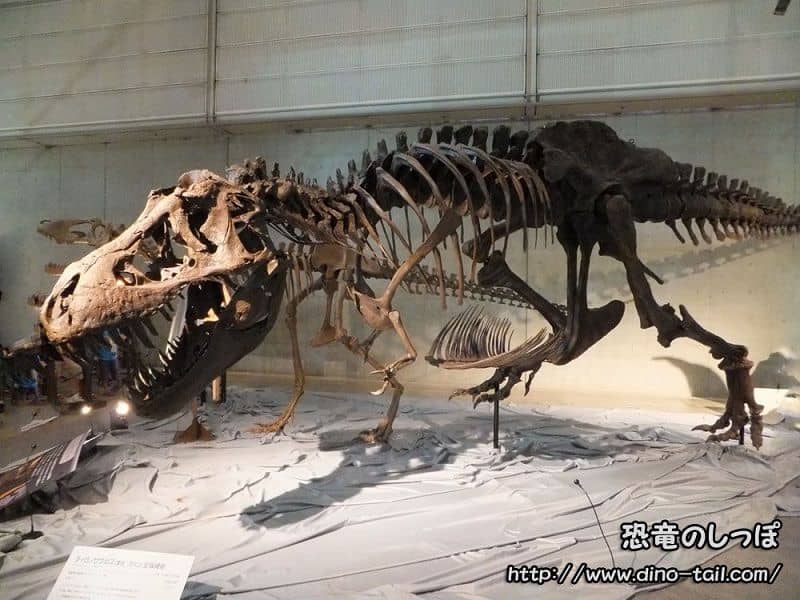
For a long time, it was thought that there was only one species in the genus Tyrannosaurus, "rex." As a result, the names "Tyrannosaurus rex" and its abbreviation "T-REX" have become widely established.
However, in 2022, a research team proposed that the genus Tyrannosaurus could be divided into three species based on the robustness of the skeleton and differences in tooth shape:
rex (Tyrannosaurus rex)
,
regina (Tyrannosaurus regina)
, and
imperator (Tyrannosaurus imperator)
. This theory drew much criticism and is not widely accepted today, but it sparked an interesting debate about the diverse individual variations within Tyrannosaurus.
Then, in 2024, a new species was added to the genus Tyrannosaurus, becoming a major topic of discussion: "Tyrannosaurus mcraeensis." This new species was identified based on a partial skull and lower jaw fossil (holotype: NMMNH P-3698) discovered in the Late Cretaceous Hall Lake Formation of New Mexico, USA. Tyrannosaurus mcraeensis is believed to have appeared about 6 to 7 million years earlier than Tyrannosaurus rex, making it a very important discovery for unraveling the mysteries of Tyrannosaurus evolution.
With its powerful jaws and large, sharp teeth, Tyrannosaurus is thought to have crushed the bones of its prey. Its bite force was several tons. The largest teeth were 30 cm long. The edges of the teeth had serrations, like a steak knife, making them well-suited for tearing flesh.

Its hands (forelimbs) were extremely short and had two fingers.
At the "Super Carnivorous Dinosaur T.Rex Exhibition" (2016) held at the Gunma Museum of Natural History, it was suggested that "it had the strength to lift about 200 kg with one hand and may have used them for support when standing up from a resting, crouched position." Also, in 2017, a paper was published suggesting that "they were used to inflict deep cuts on prey after biting" (however, many scientists have expressed opposing views on this theory).
Compared to other dinosaurs, the eyes of Tyrannosaurus were forward-facing. This allowed for stereoscopic vision (the ability to accurately perceive the distance and speed of prey), making it well-suited for catching moving animals.
In recent years, a theory that overturns this ferocious image, suggesting "it had lips covering its teeth," has been proposed and has become a hot topic. According to a study published in 2023, the enamel on Tyrannosaurus teeth was thin and would have dried out and become damaged quickly if exposed like a crocodile's teeth. Instead, it is more likely that, like modern monitor lizards, it had thin, scaly lips that covered its teeth and kept them moist. If this theory is correct, our image of the face of Tyrannosaurus will have to be significantly redrawn.
Lifespan and Growth of Tyrannosaurus
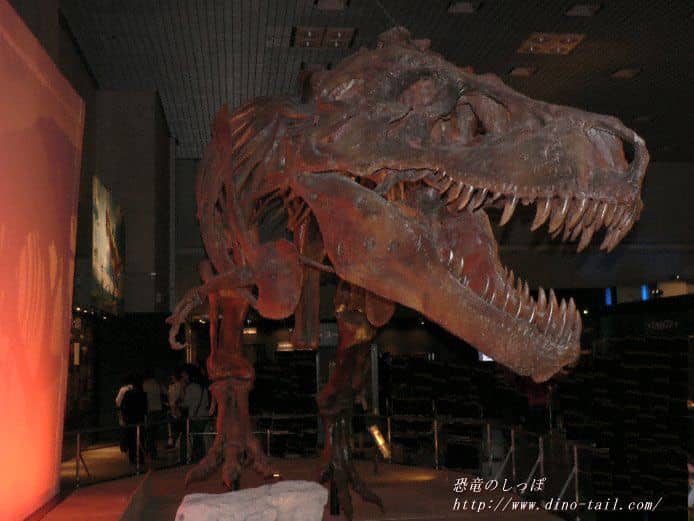
The individual nicknamed 'Sue' was found to have died at the age of 28.
The age of a dinosaur is estimated by examining the growth rings in the cross-section of its fossilized bones. The lifespan of Tyrannosaurus is estimated to be about 30 years.
However, when they hatched from eggs, they were only 60 cm long and weighed 2 kg. By the time they were two years old, 60% of them had died.
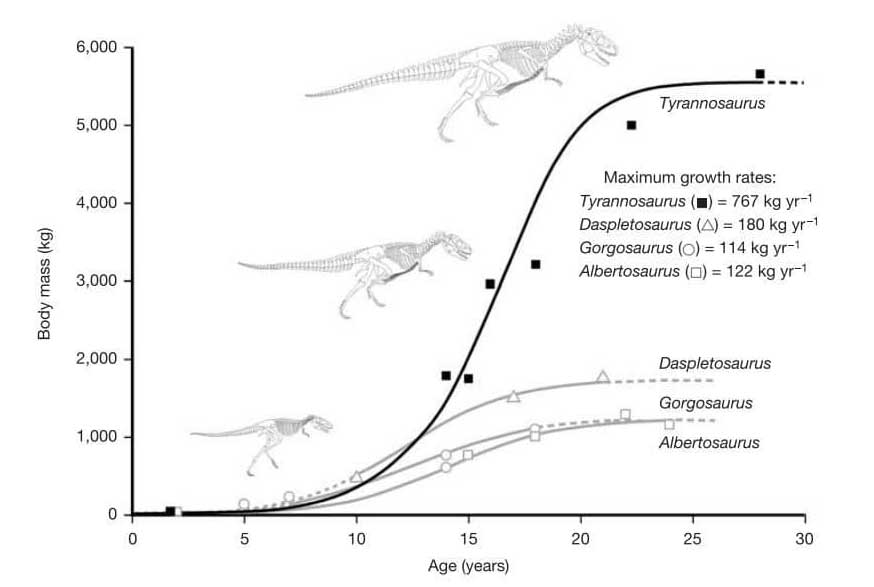
"Gigantism and comparative life-history parameters of tyrannosaurid dinosaurs.", 2004.
by Erickson, Gregory M.; Makovicky, Peter J.; Currie, Philip J.; Norell, Mark A.; Yerby, Scott A.; Brochu, Christopher A. Nature.
Also, in 2004, a research team in the US examined seven specimens and concluded that "their growth spurt was between the ages of 14 and 18, during which time they grew by 2.1 kg per day, gaining 3,000 kg in four years."
Traces left on fossils show that "many Tyrannosaurus suffered from injuries or joint diseases as they approached the age of 30."
Cannibalism
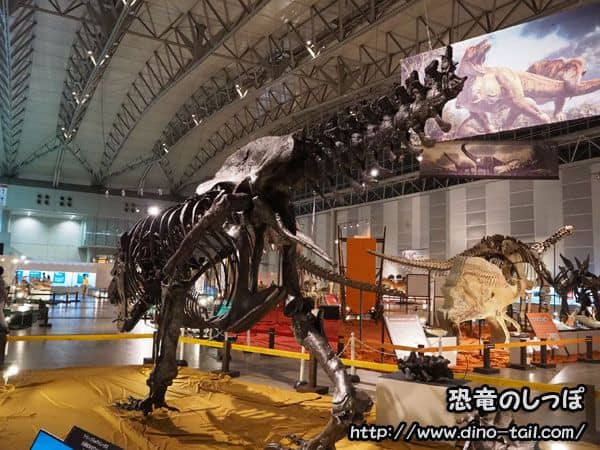
The tail of a Tyrannosaurus discovered in 2002 (nicknamed Wyrex) was severed as if bitten off, and furthermore, signs of infection were found at the severed section.
The presence of infection at the severed point suggests that Wyrex's tail was bitten off while it was still alive. The only creature in the Late Cretaceous capable of biting off the tail of a grown Tyrannosaurus is presumed to be another Tyrannosaurus.
In 2010, a Tyrannosaurus leg fossil with four bite marks was discovered. However, it is not known whether these wounds were inflicted while it was alive or if it was eaten by its own kind after death.
Social Behavior: Solitary Hunter or Pack Leader?
Whether Tyrannosaurus acted alone or hunted in packs has long been a topic of debate. In recent years, evidence has been presented suggesting they may have formed family-based groups.
Bonebeds containing multiple tyrannosaurids (such as Albertosaurus) that died together have been discovered in Canada and the United States, which is considered strong evidence that they moved in groups. It is possible that Tyrannosaurus, like wolves, had a complex social structure where experienced adults led and taught the young how to hunt.
The Feather Debate
"Did Tyrannosaurus have feathers?"
This debate is not yet settled.
Since feather impressions have been found on small theropods closely related to Tyrannosaurus, such as Dilong, there is a theory that "it may have had feathers when it was small (as a juvenile) and had difficulty regulating its body temperature." It was thought that "when the body is small, the surface area to volume ratio is large, so it was covered in feathers to retain body heat, but as it grew larger, the surface area to volume ratio became smaller, and the feathers were lost to release heat" (the same principle as a cup of hot water cooling faster than a bathtub of hot water).
In 2012, an 8-meter-long large theropod, considered a close relative of Tyrannosaurus, was described, and feather impressions were found on this specimen. It was Yutyrannus. Therefore, some scientists believe that adult Tyrannosaurus also had feathers, but a paper was published in 2017 suggesting it was covered in scales. The debate over whether it had feathers or not is likely to continue for some time.
Population Density and Numbers
In 2021, a paper was published on the population density and numbers of Tyrannosaurus.
The research team estimated the number of Tyrannosaurus using the relationship between "animal body weight" and "population density" (a principle known as Damuth's Law, where larger animals have lower population densities).
According to their calculations, they believe that one Tyrannosaurus lived within a radius of 6 km. This would be about 20 individuals in an area the size of Tokyo.
The research team's calculations estimate that 20,000 Tyrannosaurus lived simultaneously in a habitat ranging from Alaska, USA, to Mexico, and that a total of 2.5 billion individuals existed over a period of about 2-3 million years (the calculations show a range of "140 million to 42 billion," with a median of 2.5 billion).
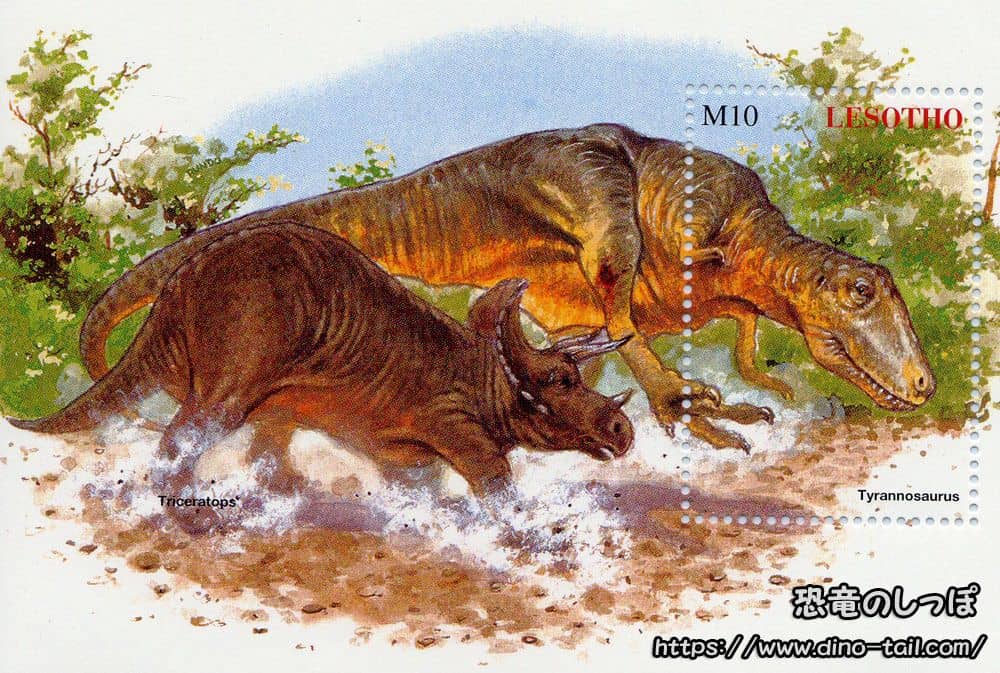
Dueling Dinosaurs: Tyrannosaurus vs. Triceratops
One of the most dramatic pieces of evidence about the ecology of Tyrannosaurus is the "Dueling Dinosaurs," a fossil of a Tyrannosaurus and a Triceratops locked together in combat . This specimen includes a young Tyrannosaurus.
This Tyrannosaurus boasts an astonishing state of preservation, with nearly 100% of its skeleton intact. Even more importantly, extensive skin impressions have been preserved. This has directly proven that the soles of the Tyrannosaurus's feet were covered in reptile-like scales.
Furthermore, ongoing research is attracting worldwide attention as it may finally settle the long-standing debate over whether this Tyrannosaurus is a "small tyrannosaurid" known as Nanotyrannus, or a juvenile Tyrannosaurus.
First Publication
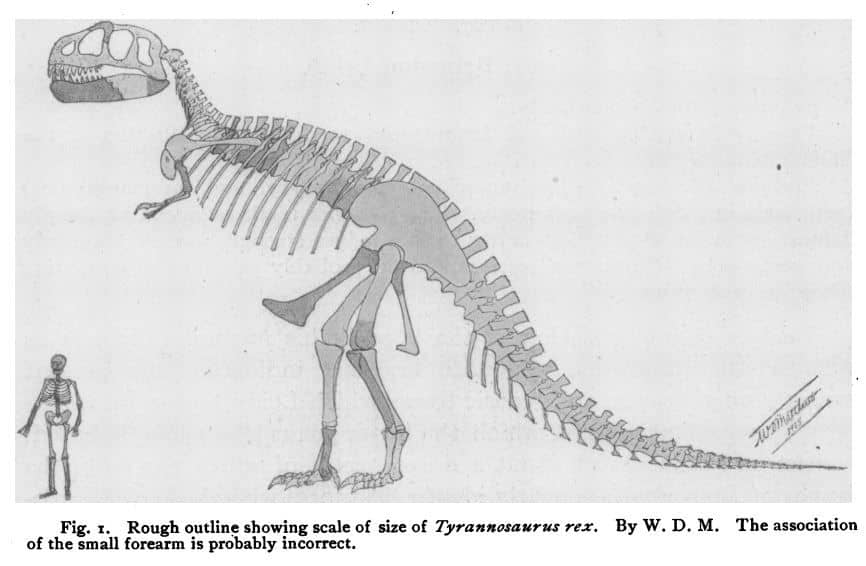
Source: Tyrannosaurus and other Cretaceous carnivorous dinosaurs. Bulletin of the AMNH ; article 14. by Osborn,1905.
The name Tyrannosaurus was first published in a paper in 1905. Based on a fossil excavated in Montana, USA, in 1902 (specimen number AMNH 973), paleontologist Osborn named and described it as the new genus "Tyrannosaurus" three years later. At the time the paper was published, specimen AMNH 973 was reportedly still being cleaned. (Specimen number AMNH 973 was later changed to CM 9380 after it was moved to a different museum).
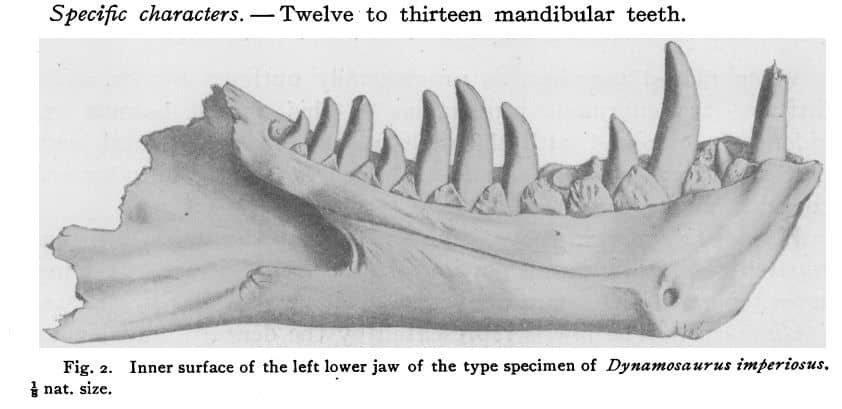
Source: Tyrannosaurus and other Cretaceous carnivorous dinosaurs. Bulletin of the AMNH ; article 14. by Osborn,1905.
In the same paper, Dynamosaurus imperiosus was also described as a separate genus and species. It was described based on specimen number AMNH 5866, which was excavated in 1900. However, the following year, in 1906, Osborn re-described Dynamosaurus as a synonym of Tyrannosaurus. After cleaning of the aforementioned specimen number AMNH 973 was completed, no clear differences were found between the two. It is presumed that Osborn chose to keep the name Tyrannosaurus instead of Dynamosaurus simply because Tyrannosaurus was described first in the 1905 paper.
Specimen Nicknames
As one of the most popular dinosaurs, many Tyrannosaurus specimens have been given nicknames.
Here are a few of them.
Black Beauty
Specimen Number RTMP 81.6.1
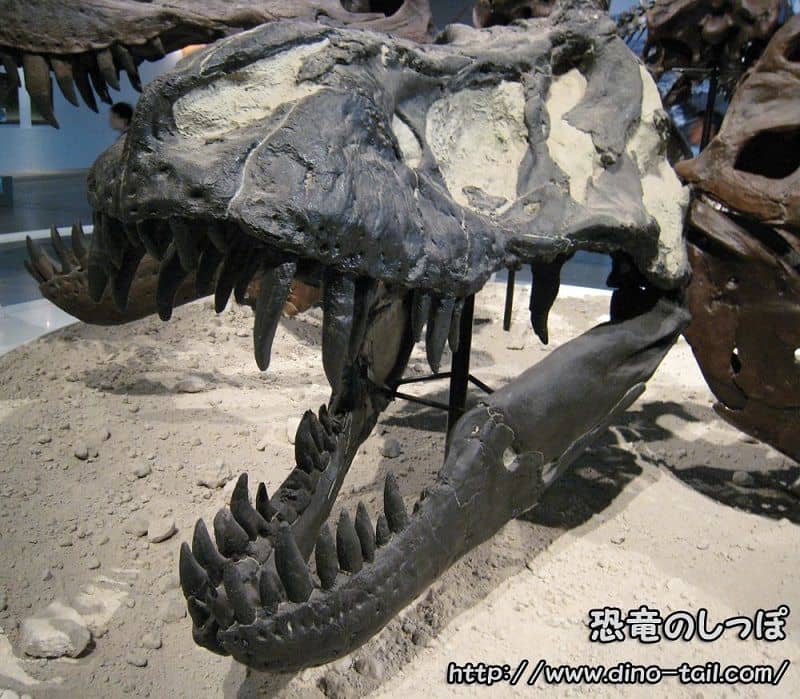
This specimen was discovered in the Willow Creek Formation in Alberta, Canada (exposed parts were found by high school students on a fishing trip in 1980, and full-scale excavation began in 1982). The nickname "Black Beauty" comes from the fact that the fossil turned black due to manganese staining during the fossilization process.
Features of the upper lacrimal bone suggest that this individual was young.
The original specimen (specimen number RTMP 81.6.1) is housed at the Royal Tyrrell Museum in Canada, but a replica can be seen at the Ibaraki Nature Museum in Japan.
Stan
Specimen Number BHI 3033

It was excavated in Harding County, South Dakota, USA, in 1987.
Stan's skull and ribs show signs of healed injuries.
Until 2014, a full-body replica of Stan was on display at the National Museum of Nature and Science in Tokyo (as of 2018, a replica of "Bucky" (specimen number TCM 2001.90.1) is on permanent display).
Wankel Rex
Specimen Number MOR 555
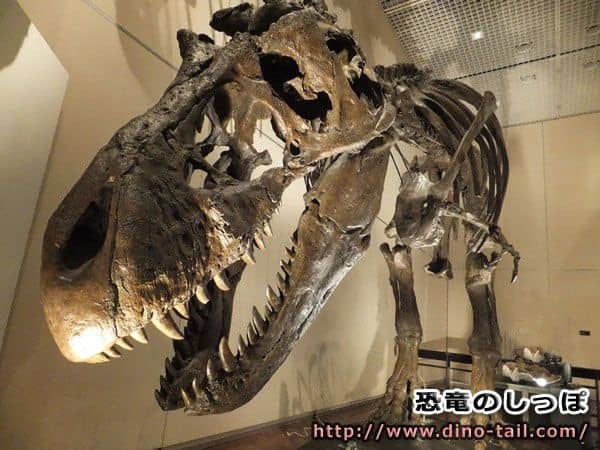
It was excavated in 1988 at the Charles M. Russell National Wildlife Refuge in Montana, USA. The original specimen (specimen number MOR 555) is owned by a U.S. Army facility and is currently on loan to the Smithsonian National Museum of Natural History (agreed to be on loan until 2063). The nickname "Wankel Rex" comes from its discoverer, Kathy Wankel.
Wankel Rex is estimated to have been around 18 years old when it died.
Sue
Specimen Number FMNH PR 2081

Sue was excavated in 1990 on an Indian reservation in South Dakota, USA. The nickname "Sue" comes from its discoverer, paleontologist Susan Hendrickson.
It boasts a preservation rate of over 90%, one of the highest for a dinosaur skeleton. It is estimated to be 12.3 meters long.
Traces of arthritis and gout from injuries sustained during its lifetime have been found. It is estimated to have been 28 years old when it died.
What made the name "Sue" widely known was the 1997 auction. The Field Museum of Natural History in Chicago won the bid for $7.6 million (including the auction house's commission, the total payment was about $8.36 million, or about 750 million yen at the time). The original specimen (specimen number FMNH PR 2081) is owned by the Field Museum of Natural History, which won it at auction.
Scotty
Specimen Number RSM P 2523.8
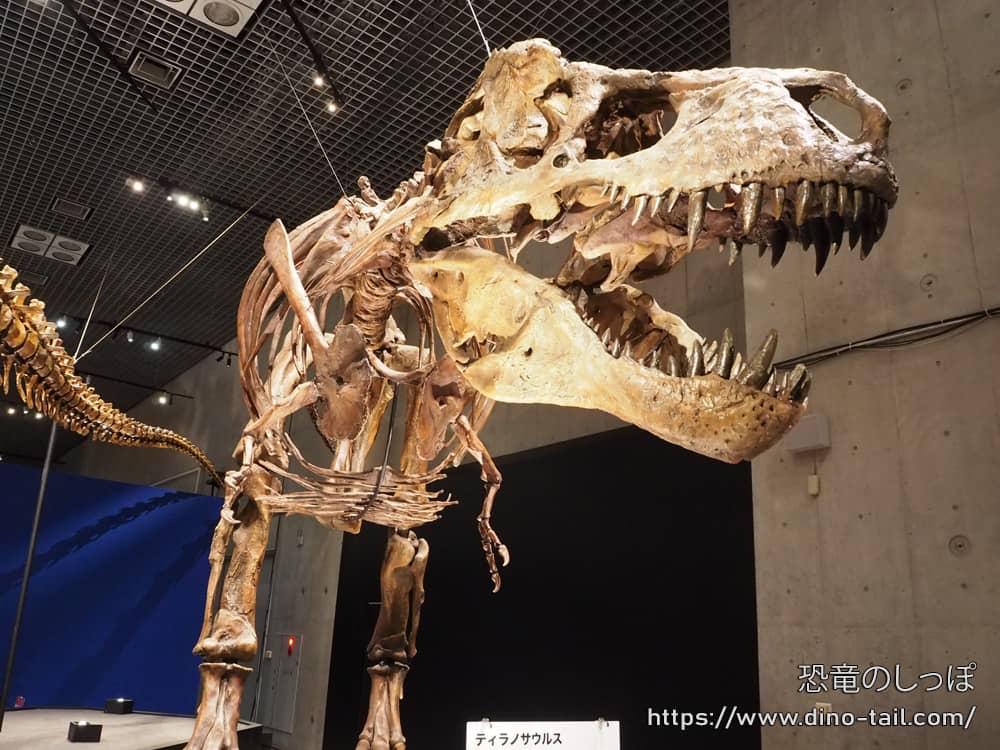
Scotty was discovered in Saskatchewan, Canada. It was discovered in 1991 by a local high school teacher and a museum curator, and full-scale excavation began in 1994.
The nickname "Scotty" comes from Scotch whisky. It is said to have originated from drinking Scotch to celebrate at the excavation site.
Larger than Sue, Scotty was estimated to weigh 8,870 kg in 2019, making it the largest Tyrannosaurus individual.
Jane
Specimen Number BMRP 2002.4.1

It was excavated in Montana, USA, in 2001.
It was a young individual, 6.5 meters long. It is estimated to have been 11 years old when it died. The possibility of it being a separate genus, Nanotyrannus, has also been suggested.
It seems to have been a fast Tyrannosaurus, with long legs for its size.
The original specimen BMRP 2002.4.1 is housed at the Burpee Museum of Natural History in Illinois.
